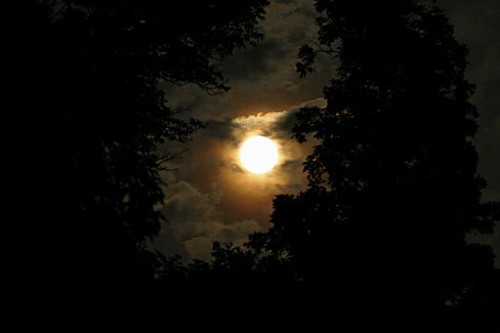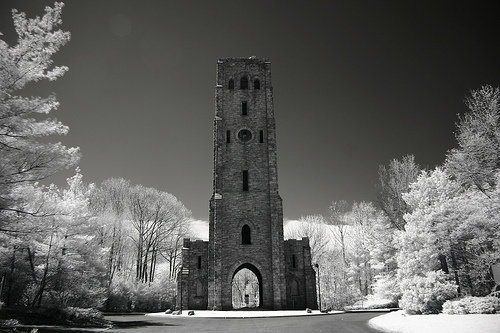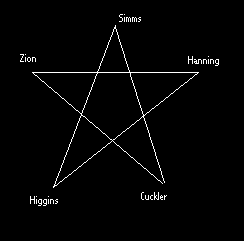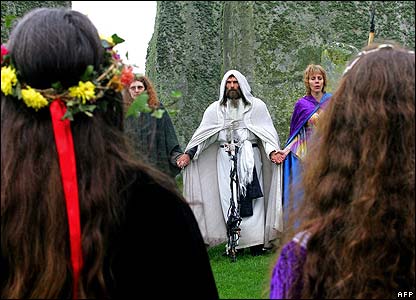Under the light of a full moon, four teens creep through the crooked iron gates of a long-forgotten cemetery hoping to witness a vampire emerging from his scared crypt. They carry candles, matches, and a package of dime-store incense…

By Kabir Bakie via Wikimedia Commons
Does this story sound like the beginning of a teenage thrasher film? A Scooby Doo episode? It’s neither. The narrative is actually an example of a very common-place phenomenon: “legend-tripping.” Gail de Vos, storyteller and adjunct professor, defines legend-tripping as:
…an organized journey to an isolated area to test the bravery of the group when faced with supernatural phenomena. The trip experience involves the telling of appropriate legends… Sites include cemeteries, tunnels, deserted and “haunted” houses, and remote lanes and bridges. (From Tales Rumors and Gossip, 1996)
Have you ever gone legend-tripping? Think back.
When I was seventeen, my friends and I heard a story about an old stone tower eight miles north of town. The structure was supposedly an inverted cross built by the Satanist who owned the surrounding land. The blood of his sacrificed victims stained the floors of the locked tower gates. If you drove around the tower backwards, you could hear Satan’s spirits speak.

Courtesy of Flickr’s Scaramouch
The call of this legend was absolutely irresistible. We stuffed our teenage-selves into an old VW Scirocco and headed north. After several visits to “Devil’s Tower,” we finally had the nerve to drive around the tower but certainly not backwards. We weren’t going to tempt Satan. What would he do to a bunch of Jewish kids who didn’t believe in him? Needless to say we were scared s**less grossly unprepared. On the very last excursion, one of my friends was drunk brave enough to creep up to the iron gates. After he got back in the car, that beat-up old Scirocco never accelerated so fast.
What does legend-tripping have to do with Paganism? A whole lot. Most trips involve the seeking out of the paranormal or the Occult (e.g. The Blair Witch Project.) In many cases, the teens use what they imagine to be magic in order to intensify the experience. In Aliens, Ghosts, and Cults: Legends We Live (2003), Bill Ellis explains that “teens often fabricate evidence of cult sacrifices, even to the extent of killing animals and leaving occult symbols behind at the site.” (Page 162) He includes legend-tripping examples such as this one from Ohio which “focuses [on five] small cemeteries [which] contain the graves of witches and therefore serve as a meeting place for black magic.” (p 223) These cemeteries reportedly form a geographical pentagram.

Athens Ohio Cemetery Pentagram
This teenage rite-of-passage grazes the “outer banks” of Paganism through its connection to the Occult. As such, we need to be aware of its practice. On the one hand, the legend-trip may be the first way a teen, as a genuine seeker, experiences the Craft. On the other hand, the Occult connection may perpetuate negative stereotypes about Witchcraft and associated Pagan religions.
Wild Hunt contributor, Stacey Lawless shared this memory:
I was hanging around with three friends one night and the talk turned to the Occult. We decided to go to “The Thread,” a waterfowl impoundment in Durham. It was a patch of woods and swamp off the highway with an eerie atmosphere. Jim went on ahead and vanished into the dark. He’d only been gone a few minutes when Steve started looking around wildly as though he heard something. Megan staggered and had to catch herself against me and I felt a strange pressure in my head. We bee-lined it back to the car. Jim caught up with us wondering what was wrong. “ Didn’t you feel anything?” Steve asked. “Nope,” said Jim. “There was a big spirit guarding the place, so I challenged it to a duel, but nothing happened. And then you guys freaked out.
Stacey and her friends may have had a genuine supernatural encounter. For most kids, the sensations would be written-off as a product of the “fear” (or “beer”) factor. However, for others, this first “contact” may ignite or be the result of an Occult sensitivity. Inexperienced teens with limited resources may use legend-tripping as a doorway to Witchcraft.
Unfortunately, authorities and media also confuse Satanic-themed teenage fun with honest Pagan religious worship which can result in a dangerous backlash against local Pagan practitioners. Criminologist J Hayward tried to disentagle “Satanic” vandalism from legend tripping in his 1998 article entitled, “Occult Crime: Satanic Evil or Legend Trip?” He wrote:
There is belief among some that the desecration of churches and cemeteries… animal sacrifice and mutilation, and various indignities done to the dead can be attributed to persons committed to and motivated by occult or satanic beliefs. The extent to which this belief is correct is not easy to gauge… only a few are suggestive of anything more sinister than library book dabbling, legend-tripping, intoxication, adolescent misbehavior, and varying degrees of psychological instability.
While reporters and the police attempt to separate Satanic practice from teen pranks, we are attempting to differentiate ourselves from the both. What’s left is a messy tangle of confusion with Occult at its center.
There is yet one last relationship between Paganism and legend-tripping. This teenage activity is part of a broader anthropological concept called “ostention.” Gail de Vos defines ostension as “the process by which people act out themes or events found within folk narratives… The legends are believed and acted upon and then the new stories are told and retold to validate the original legends.”

Pagans at Stonehenge.
By that definition, some academics consider all newly emerged Pagan religions to be products of ostension. In Legend-Tripping Online: Supernatural Folklore and the Search for Ong’s Hat, Michael Kinsella writes “Occult texts strive to develop authenticity and authority by claiming, if not outright boasting, direct lineages from ancient cultures…Wicca has quite successfully written its own history.”
Is he right? Are we just trying to relive a legend or myth? Does it honestly matter? Mythology and legends are social texts that have been used to teach cultural ethics and religious beliefs for centuries. What is the Bible but a series of stories from ancient cultures that contain truths for Christians?
Kinsella goes on to say, “By applying the frames of supernatural legends and occult texts, individuals and groups may discover and create… new ways of thinking of themselves and interacting with the world.” As such, ostension contributes to social evolution. It allows us to perpetuate and experience our world – even religiously. Through legend-tripping, teens use ostension, or legend-tripping, to test the boundaries of everyday life. We use ostension to go beyond the boundaries of everyday life.
The Wild Hunt is not responsible for links to external content.
To join a conversation on this post:
Visit our The Wild Hunt subreddit! Point your favorite browser to https://www.reddit.com/r/The_Wild_Hunt_News/, then click “JOIN”. Make sure to click the bell, too, to be notified of new articles posted to our subreddit.

I grew up in Maryland and I remember that the residents of Burkittsville were distinctly unamused at the attention “The Blair Witch Project” brought their town, especially since there was no such legend until the movie created it.
That case seems to sit on a line between legend-tripping and…whatever the word is for visiting places that movies have made famous (Forks, WA for example, which now has an actual tourism industry).
I would not worry about my Paganism being the product of ostention. I did not go looking for it; it came looking for me.
Yeah, I have trouble seeing that notion applying as much more than an attempt to ‘explain away’ Pagan and other religious experience and practice as simply people experiencing a psychological phenomenon: the problem there is it doesn’t *fit.* Pagan people simply have a different context for these things from which we approach near anything that may resemble ‘ostension’ as described.
In some cases, one might loosely say we do it deliberately, embracing ritual quests or pilgrimages or mythic quests and journeys. ‘Pilgrimage’ may be similar in that way.
Certainly when accompanying people going ‘legend-tripping’ in younger days, those of us in my little shamanic group just didn’t have the attitude of *tourists* about it. More like chaperones. The thrill-seeking/tempting ‘the paranormal’ factor is less of a thing when you’ve actually got the talent and some context of your own in which to just check it out. A lot of it just seems like ‘playing chicken’ to me, honestly.
The thrill-seeking/tempting ‘the paranormal’ factor is less of a thing when you’ve actually got the talent and some context of your own in which to just check it out. A lot of it just seems like ‘playing chicken’ to me, honestly.
But I’ll note that it seems that for a lot of the ‘trippers’ that way, it’s almost part of the archetype to bring someone like me along. Which seems reflected in hollywood treatments of these kinds of things, …someone who’s a psychic or witch (or ‘dabbler’ ) or person from a different culture or would/be ‘expert’ comes along or is consulted. (Of course that character is either not heeded or is otherwise ineffectual, since it’s otherwise not much of a horror movie. )
)
Anyway, I have trouble attributing religious cultures *to* these things since they seem to apply *across* and *from* different religious cultures and practices. I think it’s much simpler to attribute these things to how people in ‘mainstream’ cultures react *to* the lack of mystery in the regular world, either because that’s confined in churches or ‘explained away’ by exclusively rationalistic views.
One person’s legend-tripping is another person’s religion. Legends are part of the fabric of how we make meaning and how religions inspire us.
An excellent legend tripping site and magazine are Weird NJ. They collect all those legends and stories we grew up with, Devel Tower among them, and explore the troths as well as the crazy stories kids pass down from generation to generation.
I think we need to be wary about automatically connecting Paganism and the Occult. There is some overlap, perhaps, but they are not synonymous.
Where is the line between ‘legend-tripping’ and pilgrimage?
Certainly, clearly-different flavors of the same journey. The pilgrimage is likely to be organized by something bigger than the pilgrims directly involved. One looks for inspiration and the other for panic-kicks, but aren’t those both engagements on a deeper than usual level? Good question.
Don’t forget the souvenirs that pilgrims buy and by doing so help the local economy!
Interesting! I recently moved into a house near an abandoned Christian campground. The camp is very picturesque, with falling down buildings and peeling chairs on the front porches. I’ve walked through it and there is strong energy around the fire pit that I assume comes from generations of people worshiping their God in the same spot. The overall feeling — for me, anyway — is peaceful.
However, by coincidence, last Saturday afternoon I saw some teenage boys packing in camping gear. At the time, my SO and I made jokes about the sweet smell of marijuana that would be wafting through our yard that evening and thought nothing more about it. After reading your article, I did a quick Google search that revealed a legend about camp counselors who went crazy and hanged all the campers before hanging themselves. One teenager who went legend-tripping said she felt like she was being watched and she started to feel sick after being there only a short time.
Now I’m curious to see if any of the black-clad young gentlemen who camped there left behind any occult symbols…
I wonder how many of those kids who go legend-tripping and then “feel” something or get physically ill are really doing nothing more than creating a self-fullfilling experience. They expect to have something “supernatural” happen to them, and so their minds create the circumstances where they end up experiencing something “supernatural” but not too “supernatural” as to really shake the foundations of their beliefs.
Spiritual placebo is an all too common phenomenon. People can convince themselves of almost anything, if they want to.
I have to wonder how many people do this and then chalk it up as a genuine religious experience.
“Spiritual placebo” is a hazardous concept. Pressed far enough it can dissolve any personal religious/spiritual experience.
I’d be inclined to agree. It is why I am distrustful of UPG. I prefer to analyse and investigate any experience I have, to see if I can’t verify it, somehow. I find it works quite well.
No reason to trust anyone else’s UPG. I had one, and you may have heard me mention it as part of my history, but I’ve never tried to share it. That call was for me.
I don’t trust my own UPG, and would suggest that others be wary of their own experiences.
Being open minded works both ways, after all.
One needn’t trust one’s own UPG to be something supernatural or sent from a higher power, to nonetheless regard it as an important holler from one’s unconscious mind, perhaps about un-tended-to business.
Even then, it still needs analysis.
I wonder the same thing. My feelings there are completely different, and I suspect it has more to do with expectations than anything else. But I’ve also had one or two experiences in the past where I felt something and didn’t have a framework for it, and it scared me witless. Later, in the same environment and having learned a few things, feeling the same energies didn’t upset me. So maybe the teenager felt the same energy I did but it scared her because she didn’t have a framework to process it — and she assumed it was “evil” because of the scary story she’d heard.
Yes, I’ve also had very weird experiences to the point that I actually thought at one point that I was having a mental breakdown. One of the experiences, for which I still have no explanation, logical or otherwise, involved something “taking me over”. Scary? You bet! I trained myself to sleep on my back and have been doing so for almost 40 years now so it would never happen again. But as I said, despite my discussing the incident with someone I trusted and who I knew had more knowledge about the “occult” than me, I still don’t have a satisfactory explanation for what happened. Probably never will.
Thanks for this wonderful observation, Heather. Ostention is one of the most powerful communicative tools we humans have created. It is capable of explaining concepts that as yet have no literal equivalent in any spoken language. It is also capable of engendering murderous hatred and destruction, an example being the Nazi salute.
Thank you, David. I found the idea very interesting as well. The text is the text. How it is used is left to the reader….as you pointed out.
My own legend-trip was in Mount Hope Cemetery in Rochester, NY in 1975. See http://www.fomh.org/AboutUs/History/History_SleepersCity/ for a link to an article (pdf). It is well worth visiting for its history, art and natural beauty alone.
Very interesting article; I had not heard of ostention. I can see the similarities to some things we do with great reverence (making pilgrimages, leaving gifts at the tomb of Marie Laveau for example).
I went hiking once on Glastenbury Mountain in the Bennington Triangle in Southwestern Vermont.
I went missing and despite an exhaustive search by local law enforcement and SAR teams, I was never ever heard from ever again.
It is suspected that I fell afoul of the legendary Bennington Monster.
I’ll be needing some evidence for this, otherwise you are simply besmirching the character of the Bennington Monster. Any accusations of such wrongdoing must be accompanied by dodgy photos or shaky camera work. (No autofocus or HiDef, please.)
I’m impressed with your possession of someone to post this.